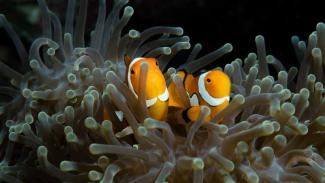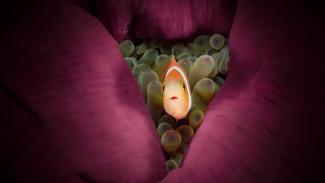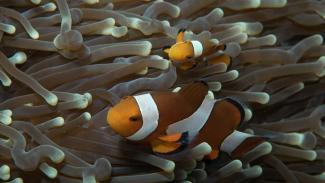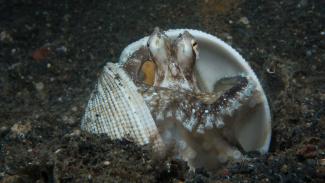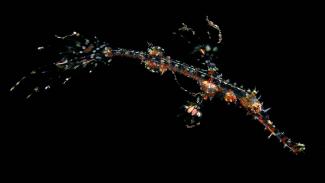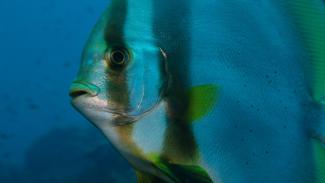Clownfish are great subjects for underwater photographers.
Not only are they colourful and full of character, but they are also one of the most iconic and well recognised fish in the sea. A good Clownfish photo nevers fails to provoke a reaction from your audience.
They are also a very tricky subject to photograph, leaving many budding photographers frustrated.
So what can you do to get a great shot?
Here's how....
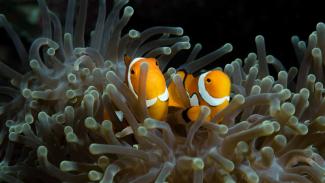
Did You Know?
Freezing the action
The first problem with Clownfish is their speed of movement. They are quick and skittish, rarely staying still long enough to compose a good shot.
They are also very territorial, frequently darting aggressively towards your lens. We have all had frustrating experiences where every shot is blurred, or the Clownfish is only partly in the frame.
To overcome this, you need to freeze the movement so that it is sharp. If you have a simple compact camera with no manual controls, then the best way to do this is to select your camera's sport scene mode.
Sport mode is designed to capture fast action, so it is perfect for capturing your clownfish as he zips around his anemone. The mode works by selecting a fast shutter speed – the amount of time that the camera's shutter is open – preventing blurry movement.
If you camera has more controls, then you can try taking the shot in 'Shutter Priority' or 'Manual' mode – usually represented by 'Tv' and 'M' on your mode dial – and selecting a shutter speed of at least 1/500th of a second.
Colour & composition
The downside of using a fast shutter speed is that you will have less light in your shot. To overcome this problem, make sure you get as close as you can to your subject - without touching the reef of course.
The closer you are, the less distance the available light has to travel and the more colours you will have in your photo.
Getting close will also mean that the Clownfish, although very small, takes up a good proportion of your frame & does not just appear as a small orange dot in the background.
Another little trick is to pay attention to the host anemone. In a large anemone, the Clownfish can cover lots of ground, limiting your chances of getting a good shot. In a small anemone, his movements will be limited, giving you a better chance of success.
The final piece of the jigsaw is to watch the Clownfish patiently. Understanding fish behaviour is crucial to good underwater photography, so if you follow its movements for a couple of minutes, you may start to see a rhythm where before you saw only frantic, random movements. You can then use this to your advantage to capture a sharp, well-composed and well-lit shot of a Clownfish.
You may not get it right first time, but with a little bit of patience & a few attempts, you should have a shot to remember.
TOP TIPS
Select a fast shutter speed, or sports mode if you cannot select a shutter speed
Get close to your subject and wait patiently
Choose a smaller anemone if possible
Follow the behaviour of the Clownfish closely
You might also enjoy...
Negros & Dumaguete
Negros Island is a large island in the Visayas. It’s eastern shore is separated from Cebu by a narrow channel, while it’s west coast faces the Sulu Sea. Much of the diving is in the south of the island.
Like many of the Philippines dive spots, it is blessed with the combination of big fish encounters and fascinating smaller critters that will keep avid divers happy for many dives.
Underwater housing care
Jakob Owens
Buying all the kit to allow you to take photos underwater is not cheap, so you need to make your equipment lasts the test of time.
One of the major and most vital expenses is your underwater housing. Housings are often fragile and can require a lot of care and attention though. So what should you be doing to look after your housing and to make sure it has a happy and healthy life?
Lankayan
The picturesque island of Lankayan is now regarded as one of Malaysia’s finest dive destinations.
The island, which is just off east the coast of Borneo in the Sulu Sea, has only one resort, ensuring uncrowded dive sites and plenty of relaxation.
Togian Islands
The remote Togian Islands lie in the middle of Tomini Bay in central Sulawesi. While difficult to reach, the islands offer great conditions for scuba-diving all year round.
Protected on almost all sides by the tentacle-like arms of Sulawesi, this large bay is reputably the calmest in the world.
Buyer's guide to underwater video
Tara North
So, you are interested in getting into underwater videography? There’s no doubting that it’s an expensive hobby, especially in terms of the equipment you need to buy.
So this means it’s really important to buy the right camera & housing set-up first time - but without experience or being able to test different models underwater, how do you choose the right system for you?
Buyer's guide to underwater cameras
Tara North


